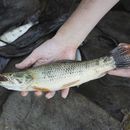Diseases and Parasites
provided by Fishbase
Klossinemella Infestation. Parasitic infestations (protozoa, worms, etc.)
Trophic Strategy
provided by Fishbase
Occurs in diverse habitats from free flowing clear water streams, well up into the valleys, to slow turbid waters, water courses, irrigation and drainage ditches, and ponds on the plains (Ref. 11225). Known to occur at a temperature range of 30-35.5 °C, ph range of 4.8-6.9, and an alkalinity range of 105-315 (Ref. 9116). Rests in vegetation during the day and is active at night (Ref. 6858). Forms schools or may occur in small groups. Is mainly diurnal (Ref. 9084). Adults feed on fish; juveniles feed on crustacean and insect larvae (Ref. 26543, 26681), shrimps and other small invertebrates (Ref. 12225). Fish 2-10 cm SL are characterized as insectivores and >10 cm SL are piscivores (Ref. 59290). Has a digestive tract adapted to a piscivorous diet, which is independent of its ontogenetic stage of development. Small individuals
Zaráte, M. et al. 1989 Evaluación de las pesquerias del embalse del Guajaro junto con algunos criterios de manejo. Trianea (Ast. Cient. Tecn., Inderena) 3:215-226.
- Recorder
- Carlos Palma Gonzales
Migration
provided by Fishbase
Potamodromous. Migrating within streams, migratory in rivers, e.g. Saliminus, Moxostoma, Labeo. Migrations should be cyclical and predictable and cover more than 100 km.
Life Cycle
provided by Fishbase
Eggs are fertilized in the cupped anal fin of the female. When the eggs get sticky, they are dropped into a pit which will be guarded by the male even until after the eggs have hatched (Ref. 205).
Diseases and Parasites
provided by Fishbase
Procamallanus Infection 10. Parasitic infestations (protozoa, worms, etc.)
Diseases and Parasites
provided by Fishbase
Eustrongylides Infestation 2 (Larvae). Parasitic infestations (protozoa, worms, etc.)
Diseases and Parasites
provided by Fishbase
Capillostrongyloides Infestation. Parasitic infestations (protozoa, worms, etc.)
Diseases and Parasites
provided by Fishbase
Heliconema Infection. Parasitic infestations (protozoa, worms, etc.)
Diseases and Parasites
provided by Fishbase
Guyanema Infection 1. Parasitic infestations (protozoa, worms, etc.)
Diseases and Parasites
provided by Fishbase
Procamallanus Infection 26. Parasitic infestations (protozoa, worms, etc.)
Diseases and Parasites
provided by Fishbase
Procamallanus Infection 25. Parasitic infestations (protozoa, worms, etc.)
Diseases and Parasites
provided by Fishbase
Paraseuratum Infestation 2. Parasitic infestations (protozoa, worms, etc.)
Diseases and Parasites
provided by Fishbase
Paracapillaria Infestation 1. Parasitic infestations (protozoa, worms, etc.)
Biology
provided by Fishbase
Occurs in diverse habitats from free flowing clear water streams, well up into the valleys, to slow turbid waters, water courses, irrigation and drainage ditches, and ponds on the plains (Ref. 11225). Rests in vegetation during the day and is active at night (Ref. 6858). Adults feed on fish; juveniles feed on crustacean and insect larvae (Ref. 26543), shrimps and other small invertebrates (Ref. 12225). Spawn in pits located in shallow water at a temperature of about 26°C (Ref. 205). Males guard the nests even after the eggs have hatched (Ref. 205). Reaches more than 3 kg (Mark Fitzgerald, pers. comm., 2001). Live fish are difficult to handle and potentially dangerous because of their sharp teeth, strong jaws, and slippery bodies.
Importance
provided by Fishbase
fisheries: commercial; aquaculture: commercial; aquarium: public aquariums
Hoplias malabaricus
provided by wikipedia EN
Hoplias malabaricus, also known as the wolf fish, tiger fish, guabine or trahira, is a predatory Central and South American freshwater ray-finned fish of the characiform family Erythrinidae.
Description

Hoplias malabaricus and its dog-like teeth.
The maximum known length for this species is about 65 centimetres (26 in) and the maximum known weight is about 3.8 kilograms (8.4 lb).[3]
Like other members of the genus Hoplias this species has a cylindrical body shape with a large mouth equipped with prominent teeth. The dog-like teeth have given it some of its common names. Coloration is highly variable but is usually grey-brown with darker vertical stripes or a single horizontal stripe.
Distribution
Southern Central America to Argentina. Found in most river systems and in the following countries; Argentina, Bolivia, Brazil, Colombia, Costa Rica, Ecuador, French Guiana, Guyana, Paraguay, Peru, Suriname, Trinidad and Tobago, Uruguay and Venezuela.[4]
Biology
Occurs in a wide range of freshwater habitats from clear, fast flowing, upland streams, to the slow turbid lowland waters, canals, irrigation and drainage ditches, and ponds and other still waters. Spends the daylight hours resting in vegetation and is most active during the night. Adults are ambush predators of fish (such as guppies),[5] crustaceans (such as shrimp and crayfish) and mussels;[6] while juveniles prey consists of crustacean and other invertebrate prey. This species spawns in pits located in shallow water and the males guard the nests even after the eggs have hatched.
Invasive species
Hoplias malabaricus are popular in the aquarium trade but are prohibited from being kept in California as a potentially invasive species. H. malabaricus was formerly established in Hillsborough County, Florida from either deliberate releases or fish farm escapes. Since January 1977 no specimens have been collected or reported; presumably the species was extirpated as result of extremely cold temperatures during that month.[7]
Gallery
References

- license
- cc-by-sa-3.0
- copyright
- Wikipedia authors and editors
Hoplias malabaricus: Brief Summary
provided by wikipedia EN
Hoplias malabaricus, also known as the wolf fish, tiger fish, guabine or trahira, is a predatory Central and South American freshwater ray-finned fish of the characiform family Erythrinidae.
- license
- cc-by-sa-3.0
- copyright
- Wikipedia authors and editors

